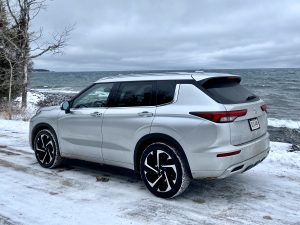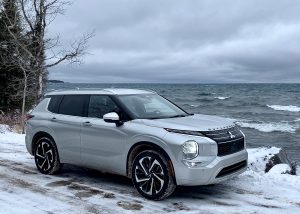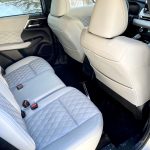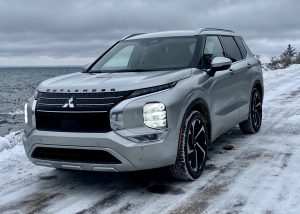Outlander proves Mitsubishi is alive and well
By John Gilbert
It seemed like it took most of a year before I got a chance to test drive a 2022 Mitsubishi Outlander SUV, and it was as much a relief to get one from Mitsubishi’s Midwest test fleet as it was to drive the midsize vehicle with what to me is a familiar name.
The Outlander has been completely redesigned, with a new platform and new engine and interior, to go along with the smaller Outlander Sport, and the even more-compact Eclipse Cross. I had feared that Mitsubishi might decide to quit marketing its vehicles in the U.S. because of the stiff competition worldwide.
I am pleased to see a resurgence in Mitsubishi vehicles. When I started analyzing and writing about new cars back in the late 1960s, it was an exciting crossroads of the industry, with some awkward and outdated American cars indignantly trying to hold off the arrival of high-mileage and high-tech imports from Japan.
Honda, Toyota, Nissan, Mazda and Subaru were trying to find their way into the U.S. market. So was a very impressive conglomerate known as Mitsubishi, made an arbitrary decision to go with Chrysler Corporation to produce some of its subcompacts like the Dodge Colt, and an amazingly durable and dependable 3.0-liter V6 that Chrysler put into various cars such as their Caravan and Voyager minivans. Those minivans were about to take over the family marketplace, and those bullet-proof engines were a big reason for their success. We have friends who put well over 200,000 on them, then gave them to their kids for another 100,000 economical miles.
Mitsubishi also built a subcompact, known as the Mirage, which in the U.S. became Dodge Colts and Plymouth Champs. They were fun and quick, and delivered over 40 miles per gallon, while the minivans were proving bulletproof.
I road-raced a Dodge Colt in the Sports Car Club of America’s new Showroom Stock category for that summer of 1970, using a Colt set up by White Bear Dodge for amateur competition. I learned a lot about road-racing when I battled a veteran driver and beat him for second place in a timed race around Donnybrooke Speedway’s 3-mile course, after which I was flattered to get the award for fastest race lap. Only then did it occur to me that if I turned the fastest lap, why was I fighting for socond instead of first?
I was impressed enough with Mitsubishi’s engineering that we bought a Colt station wagon for our young family, and later a Colt hatchback, on which y0u could screech the tires in the first three gears and still get 43 miles per gallon. As years passed, I also learned that Mitsubishi built the best electronics in the industry through its MGA televisions, tuners and speaker systems, and we enlisted in them, too.

Outlander is reinforced as the iconic top model for Mitsubishi, with even a tight third row of seats.
The arrangement dissolved as Chrysler wound up being bounced around by various investor-owners, and stand-alone Mitsubishi dealerships faded and disappeared from a lot of cities, including Duluth, Minnesota, where we now live, and where a thriving dealership was eliminated and consumers had to search the Twin Cities to find a Mitsubishi dealership.
So the 2022 Outlander carries Mitsubishi’s hopes of expanding its reach in the U.S.,, and reports have been positive. Our test Outlander carried a sticker price of $35,295, which puts it right among its competition, although the Outlander was filled with feature options.
The similarity of cars and SUVs these days is such that many of them look alike, and to stand out means to incorporate some unusual styling. The Outlander has done just that, with a prominent grille outlined at the top by sleek, thin LED lights, which curve artfully around to outline the upper grille and descend to also isolate the small blocks of LED lights on either side of the lower grille. The lights themselves are outstanding, as well as certainly distinctive.
Surprisingly, for such a blunt compact, there is actually a third row seat, which must have required a masterstroke of engineering just to wedge it in back there. We never folded the seat up, choosing to leave it down in case we had a large supply of groceries. Maybe that’s perfect, because if you need to seat seven, two or them will have to be small children, who would love to have their own kid-size seats.
As the old saying goes, better to have it and not need it than to need it and not have it.
From the side, or rear, the Outlander’s graceful lines are more conventional, which is fine because its identity is in its face. Inside, the white quilted leather seats are encapsulating, and the shifter meets what seems to have become an obligatory complexity in simply moving your choice from park to drive or neutral or reverse. In the Outlander, it is less obtrusive and you learn to rock your finger fore or aft to find your desired gear. There is a large information screen mounted nice and high in the center of the dash, and you can find more information than an ordinary driver can want.
Under the hood, Mitsubishi has installed its new 4-cylinder engine, measuring 2.5 liters in displacement with a nicely balanced 181 horsepower and identical figure for torque, which collaborate to make the Outlander quick enough and sporty enough for a family hauler. It is annoying to try to find a CVT (continuously variable transmission) that is anything but boring, but in the Outlander, large paddles on either side of the steering wheel allow you to shift through eight stops on the CVT, and if you use the paddles adroitly, you can forget you even have a CVT in the thing.
Some have accused the Outlander of leaning too far on turns, but I found it just right — better than an overstuffed vehicle but tastefully short of being racy. The EPA estimates show 24 miles per gallon city and 30 in highway driving, and we got 32 or 33 on combined but mostly city driving. Our gauge showed 32.6, for example.
It’s also evident that Mitsubishi is heading toward hybrid and electric power, and I await any plans that may be coming.
Mitsubishi maintains the tradition of offering something beyond the normal technology, and an example might be that instead of just calling it “all-wheel-drive,” the Outlander’s system is called “Super All-Wheel Control.” There are some creative ways of executing, with adjustments for setting your drive mode.
We did some experimenting on some hard ice to see exactly what difference the change in modes might make. With my son, Jack, standing outside the car to observe me on a slab of ice, I tried accelerating hard in normal, and in the slippery setting. In normal, all four wheels spun immediately in chorus; in slippery, the front wheels spun for a couple revolutions, and after a momentary delay the rear ones started to spin, too.
In overview, the new Outlander lives up to its redesign scheme by looking unique, and it lives up to Mitsubishi’s reputation of adding a few new wrinkle to the drivetrain and shifting process. It passes all the tests for comfort and economic efficiency as well, and its audio system is as good as anticipated.
For me, of course, it’s also a tremendous benefit just to know Mitsubishi is still selling vehicles in the U.S. and its positive sales since the Outlander’s redesign mean good things for the future.






 John Gilbert is a lifetime Minnesotan and career journalist, specializing in cars and sports during and since spending 30 years at the Minneapolis Tribune, now the Star Tribune. More recently, he has continued translating the high-tech world of autos and sharing his passionate insights as a freelance writer/photographer/broadcaster. A member of the prestigious North American Car and Truck of the Year jury since 1993. John can be heard Monday-Friday from 9-11am on 610 KDAL(www.kdal610.com) on the "John Gilbert Show," and writes a column in the Duluth Reader.
John Gilbert is a lifetime Minnesotan and career journalist, specializing in cars and sports during and since spending 30 years at the Minneapolis Tribune, now the Star Tribune. More recently, he has continued translating the high-tech world of autos and sharing his passionate insights as a freelance writer/photographer/broadcaster. A member of the prestigious North American Car and Truck of the Year jury since 1993. John can be heard Monday-Friday from 9-11am on 610 KDAL(www.kdal610.com) on the "John Gilbert Show," and writes a column in the Duluth Reader.